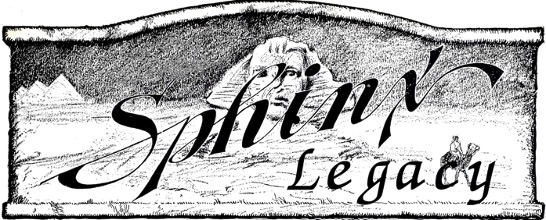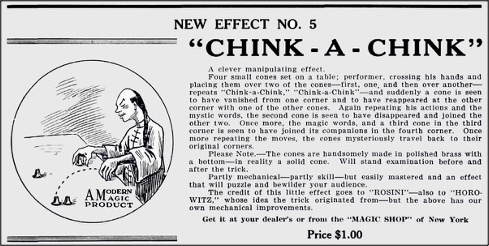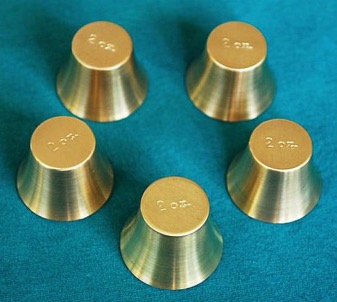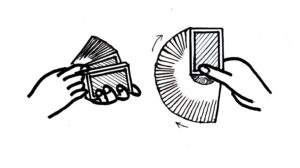“Sphinx Legacy” 編纂記 第43回
 加藤英夫
加藤英夫
出典:”Sphinx”,1927年4月号 執筆者:William Meyenberg
On page 35 of the March issue “Rosini” is given credit for the “CHINK-A-CHINK” effect. This is wrong as it is “Max Malini’s” idea and his pet trick. I merely make this correction as Carl Rosini is on the road, and I know that he believes in giving credit where credit is due.
Meyenbergが指摘した広告は以下の通りです。

たしかにこの広告文の中で、このトリックがRosiniとHorowitzにクレジットされています。Meyenbergがこの記事を書いたのは、’CHINK-A-CHINK’を流行させたのも、’CHINK-A-CHINK’がこのトリックの名前として定着したのも、Maliniが得意芸としていたからでした。
しかしながらこのトリックはMaliniが考案したものではありません。Edwin Sachsによる”Sleight of Hands”(1877年)には、原理的にはほとんど同じものが解説されています。同書に書かれているものは、いわゆるMatrix系のトリックの様式である、正方形のコーナーに位置に置いた状態で行われます。Maliniのやり方は、見た目には3個のコルクを使用すると書かれているものがほとんどですが、見た目に4個を使うと書かれている記述もありました。
この広告の説明を読むと、使う小さなコーン状の物は、金属で作られていると書かれています。私の想像ですが、これはたんにその形状の物を必要な個数セットにして、解説書をつけた商品ではないと思います。コルクや角砂糖でできるのに、金属で作ったからといって商品価値が出るとは思えません。
今回、色々と調べても、’CHINK-A-CHINK’でシェルを使うタイプの誕生に関する情報が見つかりませんでした。私はアメリカで購入したことがあるので、商品としての’CHINK-A-CHINK’としては、すぐそれを思い浮かべました。シェルを金属で作れば薄いものを作れますので、シェルのかぶってないものとシェルのかぶっているものの差の見かけが、ほとんど違いありません。
Horowitzはエクストラの角砂糖をハンカチの陰に隠しておいて、両手が空なのを見せたあと、まわりにある物をどけるときに、エクストラの角砂糖をスチールしますが、シェルを使っていれば、シェルつきのコーンの上に手をかければ、ナチュラルな動作でシェルをスチールできるのです。
以下の写真は2009年にHarry Riserが製作した金属製’CHINK-A-CHINK’です。”Martin’s Magic”サイトから引用した写真です。

この製品を使用して、Pop Haydnが演じている動画がありました。シェルをただ1個のコーンを増やすだけに使うのではなく、演技中にうまくコーンにはめたり外したりすることによって、余分なコーンを使用していない印象を強めています。以下のアドレスで見られます。半分ぐらいは話ですから、英語が苦手な方は、半分ぐらい飛ばしてご覧ください。
“Sleight of Hand”に解説されているやり方を収録しておきます。タイトルは、たんに’Sugar’としか書かれていません。
Take four well-shaped pieces, of a medium size, and place them before you on a table, at which you will sit at your ease, in the form of a square, and about a foot from each other. Hatch up a long rigmarole about one piece being the Emperor of Japan, another his wife, another his daughter, and another his prime minister, or any other rubbish you please, so long as you bring it about that it is necessary that all four should assemble together in one place.
In the country of which you are speaking, you will explain, it is the custom of Royalty to travel by telegraph, and invisible to the gaze of the “common herd.” To illustrate how it is done, you will cover two of the four pieces, each with a separate hand, and, at the word ” pass,” make a slight movement as if throwing a piece from one hand to the other. On raising the hands, two pieces will be found under one, and none under the other.
Repeat this operation (the minority always going over to the majority) until all four pieces are collected under one hand. The explanation of this really pretty, and, to the uninitiated, inexplicable trick, is, that you have a fifth piece of sugar palmed. If this piece be released, and that under the other hand palmed, the effect is the same as if an invisible journey had really been made. Supposing the five pieces of sugar to be represented by numerals, the various changes may be thus tabulated:
Left Hand. Right Hand.
1.—Raise 1 and Drop 5 with 2.
2.—Drop 1 with 5 and 2 and Raise 3.
3.—Raise 4 and Drop 3 with 1, 5, and 2.
4.—Raise both hands and pocket 4.The rough and adhesive nature of sugar renders it very easy to palm. In palming, avoid all contraction of the muscles of the back of the hand, which is visible to the audience, or a clue to the solution of the trick will be given.
If going out to a place where you are likely to be asked to exhibit yourskill, be provided with a piece of sugar, and then ask for the requisite four pieces. If you are unprovided, then you must secure possession of the sugar basin, and secrete the extra piece as best you can. The extreme simplicity of this trick is only equalled by the astonishment of the audience,who are straining their eyes to catch a glimpse of the piece of sugar as it passes. I need hardly remark that they never succeed.
(つづく)


